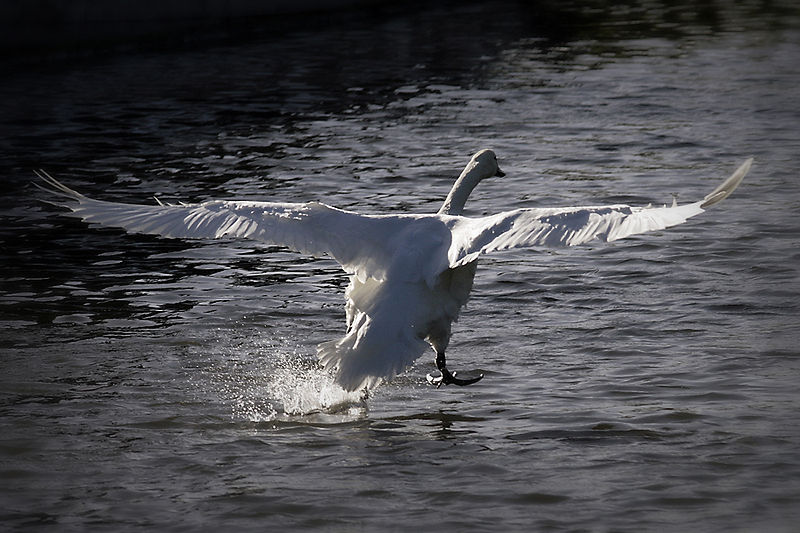The Wild Swans at Coole
The trees are in their autumn beauty,
The woodland paths are dry,
Under the October twilight the water
Mirrors a still sky;
Upon the brimming water among the stones
Are nine and fifty swans.
The nineteenth Autumn has come upon me
Since I first made my count;
I saw, before I had well finished,
All suddenly mount
And scatter wheeling in great broken rings
Upon their clamorous wings.
I have looked upon those brilliant creatures,
And now my heart is sore.
All’s changed since I, hearing at twilight,
The first time on this shore,
The bell-beat of their wings above my head,
Trod with a lighter tread.
Unwearied still, lover by lover,
They paddle in the cold,
Companionable streams or climb the air;
Their hearts have not grown old;
Passion or conquest, wander where they will,
Attend upon them still.
But now they drift on the still water
Mysterious, beautiful;
Among what rushes will they build,
By what lake’s edge or pool
Delight men’s eyes, when I awake some day
To find they have flown away?
W.B. Yeats (1865–1939)
If there is a poem that you would like to suggest for this section, send it to me at barry@middlewaysociety.org and say in what way you feel it is meaningful to you.
Image courtesy of Wikipedia commons


Sadness rises up in me at reading this poem. Sadness is an unusual emotion for me, but this poem evokes it. I feel a thickening in the throat and tears prick my eyes. It’s a good feeling, very good. I feel unusually alive.
I was once young, and trod lightly. I remember being eighteen and visiting Hackney for the first time – a job interview for nursing. I can relive travelling by Number 23 bus to Homerton, and walking to the hospital in the autumn sunshine. The Deputy Matron, Miss “Dolly” Varden, gave me a small parcel of iced cakes to sustain me on my homeward journey, I had hitch-hiked from Birmingham. It’s an act of kindness I shall never forget.
Now I’m old. The swans still wheel and cry.
Beautifully put Peter, that was a journey of discovery! Did you go on to do your nursing training in Homerton Hospital? I was a student nurse in the early 1950s at Guy’s Hospital, near London Bridge, I didn’t stay to complete the course.
Yeats wrote this poem in 1919, WW1 had just come to an end, he was in his fifties, I think the swans were a symbol of eternity?
Hi Norma, good to reflect on old times….:) I did my training at Hackney Hospital, an old London County Council institution, there were “Poor Law” wards there, in a state of disrepair and empty. The hospital blankets and sheets had “LCC” woven into them, rough old things they were too!
My room in the nurses’ hostel had no heating, and there was a night-stand with a crockery jug and bowl for washing, no running water though. When the weather was cold I used to sit in the corridor outside my room, where there was a steam radiator. I expect your privations at Guys were similar, Norma.
Homerton Hospital came much later, indeed I’ve never seen it.
I don’t know much about Yeats’s imagery, but he uses lots of birds in his poems, and their sudden movements, beating wings, their wheeling and turning – and their mysterious love – are a recurring poetic motif that captivates me.
The unknowable experience of bird-love calls to mind Robert’s reference to the experience of bats, a mind-extending notion if there ever was one!
Hi Peter, My sons used to own a house in Hackney, a minute or two from Victoria Park, a beautiful retreat from the traffic. That area has become very trendy now!
Unlike your experience, I lived in the nurse’s home at Guy’s, where the living conditions were very good, there were a few strict rules, but we students accepted them without question.
I can visualise in my mind’s eye the scene at Coole, the poem is wonderfully descriptive.
I guess that one reason Barry may have chosen this poem is that I use it as an example in my about-to-be-released book, MWP3: The Integration of Meaning. Here’s the bit where it occurs in the chapter on poetry:
Poetry as an art form seems distinguished from prose, not so much necessarily by line endings or rhythm as by metaphorical freedom. Potentially good poetry is metaphorically rich poetry, its quality almost defined by its ambiguity. This point is obviously the focus of much literary discussion, but I will illustrate it quite briefly here with a couple of well-known examples.
My first example is from W.B.Yeats’ The Wild Swans at Coole.
(here I quote the first three stanzas as above)
This poem (which continues for two more stanzas) achieves its wistful meaningfulness by bringing together two things that might otherwise have been discussed separately in quite different terms. One is the swans, carefully evoked in their context on the lake at Coole, and the second is Yeats’ feelings about ageing and the passage of time. We perceive the swans as unchanging symbols in contrast to the changing and fretful emotional states of the poet. The function of the swans here is what T.S. Eliot called an objective correlative, reflecting back and amplifying the emotional states. This means that this is neither a poem ‘about’ swans, nor one ‘about’ Yeats’ emotional states, but rather an integration of the two which reflects both more profoundly than a mere description of either would have done. What we mean by either is richly ambiguous, because it is only understood in dialectical relationship to the other.